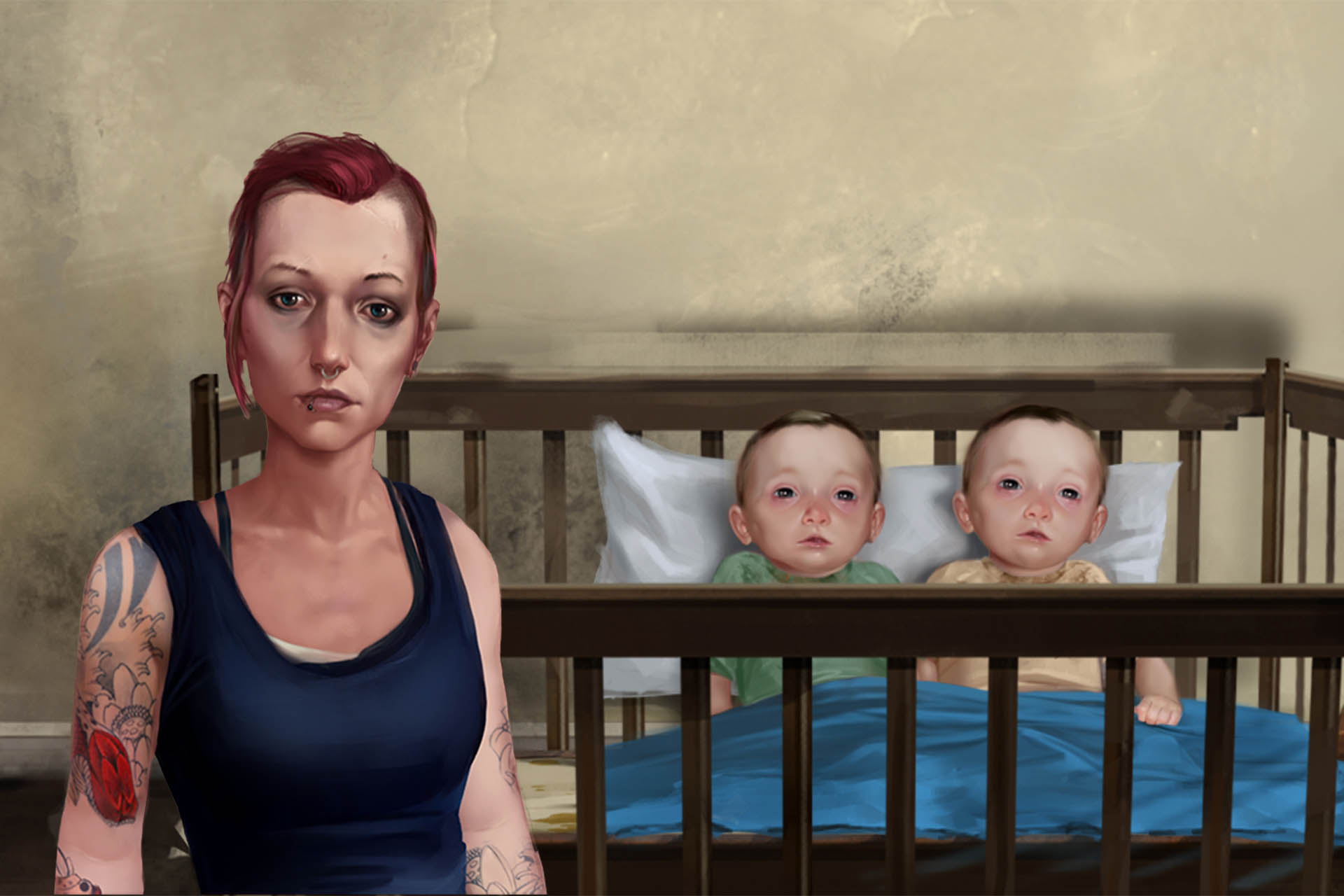Rosie 2 was written to give managers and trainers an opportunity to enable front door practitioners to explore most of the principles from the Munro review – to reduce the procedural and bureacratic practices which Professor Munro describes in each of her three reports into child protection; a world of practice which has the time, skill and desire to put families before paperwork and children before timescales.
Rosie 2 is a simulation which centres upon chronic neglect as a category of abuse. During the early days of creating the Centre, Professor Shemmings and Professor Reeves undertook investigative research with practitioners around topics which were posing significant challenges for practice – neglect was commonly discussed. ‘Rosie 2’ was therefore created to develop practitioner skills and knowledge in identifying and responding to neglect cases and it remains one of the Centre’s most popular and utilised simulations. This is likely to be because neglect continues to be a perennial child protection issue and is the highest category of abuse as evidenced by UK Government child protection statistics each year
The simulation continues Rosie’s story from ‘Rosie 1’ and examines the situation for Rosie and her family five years on. Rosie is now 9 year’s old and chronic neglect has become a key concern, particularly around her 10 month old twin siblings. The simulation consists of 13 scenes which explore a visit to Rosie’s home; a joint visit undertaken by a social worker and a health visitor.
An exploration of neglect is the key objective of the simulation but it offers many additional learning opportunities around: communication styles and skills of practitioners; working with hostile and resistant service users; managing disguised compliance; as well as direct work with children and adolescents.
The simulation encapsulates critical concerns which are repeated in Serious Case Reviews (SCRs) and bi-and triennial review of SCRs. These include: high risks of harm to those under the age of 1 and adolescents; insufficient and inadequate inclusion of men in risk assessments; parental mental ill health; and the challenges in assessing the needs of multiple children in the home and supporting their families. This again makes ‘Rosie 2’ a highly relevant and important simulation.
Other useful sources of information:
Cuthbert, C., Rayns, G. and Stanley, K. (2011). All Babies Count; Prevention and Protection for Vulnerable Babies. [Online]. Available from: http://www.nspcc.org.uk/Inform/resourcesforprofessionals/underones/all_babies_count_pdf_wdf85569.pdf [Accessed 25 September 2012].
Department for Education (2010). Building on the Learning from Serious Case Reviews: A Two Year analysis of Child Protection Database Notifications 2007-2009. DFE-RR040. [Online]. Available from: https://www.education.gov.uk/publications/standard/publicationdetail/page1/DFE-RR040 [Accessed 27 September 2012].
Department for Education (2011). Safeguarding Children Across Services: Messages from Research on Identifying and Responding to Child Maltreatment. DFE-RBX-10-09. [Online].
Available from: https://www.education.gov.uk/publications/eOrderingDownload/DFE-RBX-10-09.pdf [Accessed 24 September 2012].
Department for Education (2011). The Munro Review of Child Protection: Final Report. The Stationery Office Limited. [Online]. Available from:
https://www.education.gov.uk/publications/eOrderingDownload/Cm%208062.pdf [Accessed 27 September 2012].
Featherstone, B. (2009). Contemporary fathering: theory, policy and practice. University of Bristol: The Policy Press.
Ferguson, H. (2011). Child Protection Practice. Basingstoke; Palgrave Macmillan.
Forrester, D., Kershaw, S., Moss, H. and Hughes, L. (2007). Communication skills in child protection: how do social workers talk to parents? Child and Family Social Work, 38, 1302-19
Gladwell, M. (2001). The Tipping Point: how little things can make a big difference. Little, Brown Book Group: London.
Lefevre, M. (2010). Communicating with Children and Young People: making a difference. Bristol: Polity Press.
Moran, P. (2011). Neglect: research evidence to Inform Practice. Action for Children. Munro, E. (2012). Progress Report. Moving towards a child centred system.
[Online]. Available from: http://media.education.gov.uk/assets/files/pdf/t/the%20munro%20review%20of%20child%20protection%20progress%20report%20%20%20moving%20towards%20a%20child%20centred%20system.pdf [Accessed 25 September 2012].
NSPCC (2012a). Serious Case Reviews published 2009-2012. [Online]. Available from: http://www.nspcc.org.uk/Inform/resourcesforprofessionals/scrs/serious_case_reviews_2012_wda88142.html [Accessed 26 September 2012].
Shemmings, D. and Shemmings, Y. (2011). Understanding Disorganised Attachment. London: Jessica Kingsley Publishers.
Shemmings, D. (2018). Contemporary attachment theory: How can it inform social workers? In: Handbook for Social Work: London: Routledge.
Shemmings, D. and Shemmings, Y. (2018). Emotional and behavioural development: The importance of attachment. In: Howarth, J. and Platt, D. ed. The Child’s World. London: Jessica Kingsley Publishers.
Trevithick, P. (2012). Social Work Skills and Knowledge; A Practice Handbook. Berkshire: OUP.
Winter, K. (2011). Building relationships and communicating with young children. London: Routledge.
Bailey et al. (2013). Neglect and Serious Case Reviews. London: NSPCC [Online]. Available from: https://www.nspcc.org.uk/globalassets/documents/research-reports/neglect-serious-case-reviews-report.pdf [Accessed 21 August 2018].
Flood, S and Holmes, D. (2016) Child neglect and its relationship to other forms of harm – responding effectively to children’s needs. London: NSPCC and Action for Children [Online]. Available from: https://www.actionforchildren.org.uk/media/6762/child_neglect_evidence_scope_executive_summary_july16-1.pdf [Accessed 21 August 2018].
Assink et al. (2018). Risk factors for child neglect: A meta-analytic review. Child Abuse & Neglect. 77 (19), p198-210. [Online]. Available from: https://www.sciencedirect.com/science/article/pii/S0145213418300164?via%3Dihub [Accessed 21 August 2018].
Bowyer, S and Wilkinson, J. (2017) The impacts of abuse and neglect on children; and comparison of different placement options. London: Department for Education [Online]. Available from: file:///C:/Users/ier3/Downloads/Childhood_neglect_and_abuse_comparing_placement_options.pdf [Accessed 21 August 2018].
Brandon et al. (2014) Missed opportunities: indicators of neglect – what is ignored, why, and what can be done? London: Department for Education [Online]. Available from: https://assets.publishing.service.gov.uk/government/uploads/system/uploads/attachment_data/file/379747/RR404_-_Indicators_of_neglect_missed_opportunities.pdf [Accessed 21 August 2018].
Raws, P. (2018) Thinking about adolescent neglect: A review of research on identification, assessment and intervention. London: The Children’s Society [Online]. Available from: https://www.childrenssociety.org.uk/sites/default/files/thinking_about_adolescent_neglect_report.pdf [Accessed 21 August 2018].
Daniel, B. (2015). Why Have We Made Neglect So Complicated? Taking a Fresh Look at Noticing and Helping the Neglected Child. Child Abuse Review. 24 (2), p82-94. [Online]. Available from: https://onlinelibrary.wiley.com/doi/epdf/10.1002/car.2296 [Accessed 21 August 2018].
Office For National Statistics (2015) Characteristics of Children in Need. London: Department for Education [Online]. Available from: https://assets.publishing.service.gov.uk/government/uploads/system/uploads/attachment_data/file/469737/SFR41-2015_Text.pdf [Accessed 21 August 2018].
Farmer, E and Lutman, E. (2014). Working Effectively with Neglected Children and Their Families – What Needs To Change? Child Abuse Review. 23 (4), p262-273. [Online]. Available from: https://onlinelibrary.wiley.com/doi/epdf/10.1002/car.2330 [Accessed 21 August 2018].
